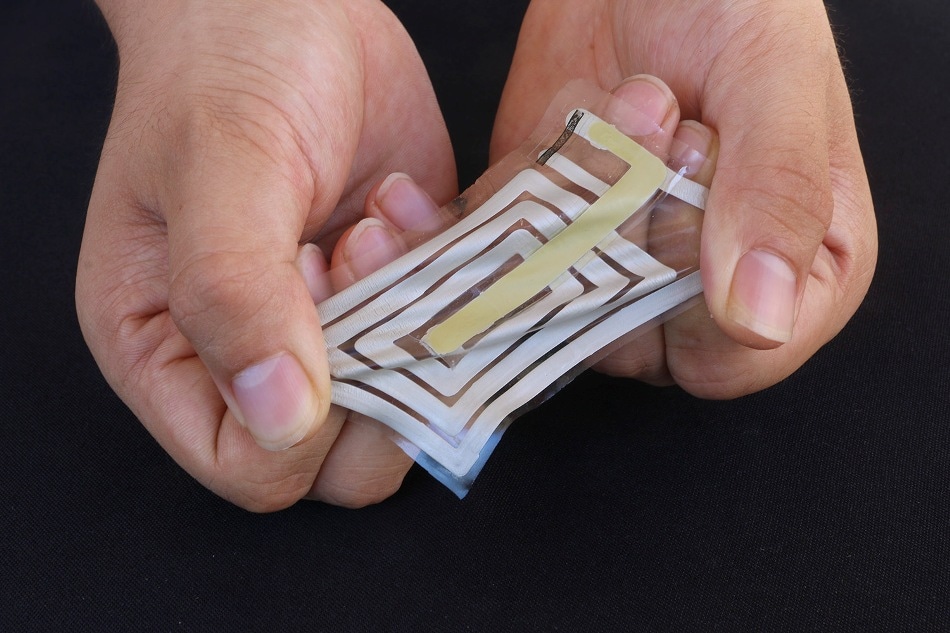Aug 19 2019
The protective function of the skin is generally taken for granted. Most often, humans ignore the other roles of the skin in signaling subtleties like a flush of embarrassment or a fluttering heart.
 Using metallic ink, researchers screen-print an antenna and sensor onto a stretchable sticker designed to adhere to skin and track pulse and other health indicators, and beam these readings to a receiver on a person’s clothing. (Image credit: Bao Lab)
Using metallic ink, researchers screen-print an antenna and sensor onto a stretchable sticker designed to adhere to skin and track pulse and other health indicators, and beam these readings to a receiver on a person’s clothing. (Image credit: Bao Lab)
Engineers at Stanford University have developed a method to identify physiological signals arising from the skin with the help of sensors that stick like Band-Aids and beam wireless readings to a receiver fixed onto clothing.
In order to illustrate this wearable technology, the scientists fixed sensors to the abdomen and wrist of a test subject to track the pulse and respiration of the person by detecting the way the skin stretches and contracts with each breath or heartbeat.
Similarly, stickers fixed to the knees and elbows of the person monitored movements of the arms and legs by determining the slight relaxation or tightening of the skin whenever the corresponding muscle flexed.
According to Zhenan Bao, the chemical engineering professor whose laboratory elucidated the system in an article published in Nature Electronics on August 15th, 2019, the new wearable technology—which the team refers to as BodyNet—will be initially utilized in medical environments like monitoring patients suffering from heart conditions or sleep disorders.
Boa’s laboratory is already attempting to create innovative stickers to perceive various secretions, including sweat, to monitor variables like stress and body temperature.
Ultimately, Boa hopes to produce a range of wireless sensors that adhere to the skin and function in tandem with smart clothing. These sensors would more precisely monitor a broader range of health indicators when compared to the smartwatches or phones currently used by consumers.
We think one day it will be possible to create a full-body skin-sensor array to collect physiological data without interfering with a person’s normal behavior.
Zhenan Bao, Chemical Engineering Professor, Stanford University
Bao is also the K.K. Lee Professor in the School of Engineering.
Stretchable, Comfortable, and Functional
Naoji Matsuhisa and Simiao Niu, both postdoctoral scholars, headed the 14-person team that devoted three years to create the sensors. The researchers’ aim was to devise a technology that would not contain any batteries or stiff circuits that tend to inhibit the stickers from contracting and stretching with the skin, and would be comfortable to wear.
The team’s ultimate design fulfilled these parameters and this was done by changing the radiofrequency identification (RFID) technology used to manage keyless entry to inaccessible rooms. When an ID card is held up to an RFID receiver, an antenna within the ID card harvests a small amount of RFID energy from the receiver, then utilizes this to produce a code, and finally beams it back to the receiver.
Similar to the ID card, the BodyNet sticker includes an antenna that powers its sensors by harvesting a small amount of the incoming RFID energy from a receiver on the clothing. It subsequently takes readings from the skin and sends them back to the adjacent receiver.
However, to make the wireless sticker actually work, the scientists had to develop an antenna that can stretch and bend just like the skin. To accomplish this task, they screen-printed metallic ink on a rubber sticker, but each time the antenna stretched or bent, those movements rendered its signal unstable or too weak to be useful.
To overcome this issue, the Stanford team created a new kind of RFID system that can beam precise and strong signals to the receiver, in spite of continuous fluctuations. Then using Bluetooth, the battery-powered receiver intermittently uploads data from the stickers to a computer, smartphone, or any other permanent storage system.
The stickers’ initial version depended on minute motion sensors to take pulse and respiration readings. At present, the scientists are exploring ways on how to incorporate temperature, sweat, and other kinds of sensors within their antenna systems.
The researchers have to resolve another difficulty to move their technology from clinical use to consumer-friendly devices—that is, keeping the receiver and the sensor close to one another. In their experiments, the scientists fixed a receiver to clothing just above every sensor.
One-to-one parings of receivers and sensors would be acceptable in medical monitoring; however, to develop a BodyNet that could be worn by a person while exercising, antennas would need to be integrated into clothing to both receive and send signals irrespective of where a person fixes a sensor.
Bao is also a senior fellow of the Precourt Institute for Energy, a member of Stanford Bio-X, a member of the Wu Tsai Neurosciences Institute; a faculty fellow of Stanford ChEM-H, and an affiliate of the Stanford Woods Institute for the Environment.
Other co-authors from Stanford University are Jeffrey B.-H. Tok, research scientist; Ada Poon, associate professor of electrical engineering; William Burnett, adjunct professor of mechanical engineering; postdoctoral scholars Yuanwen Jiang and Jinxing Li; graduate student Jiechen Wang; and former visiting scholar Youngjun Yun and former postdoctoral scholars Levent Beker, Sihong Wang, and Xuzhou Yan.
The study was also co-authored by researchers from Singapore’s Nanyang Technological University.
The study was supported by Samsung Electronics; the Singapore Agency for Science, Technology and Research; the Japan Society for the Promotion of Science; and the Stanford Precision Health and Integrated Diagnosis Center.